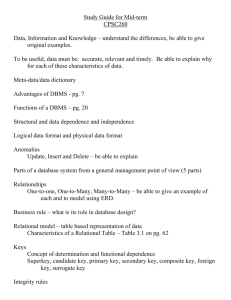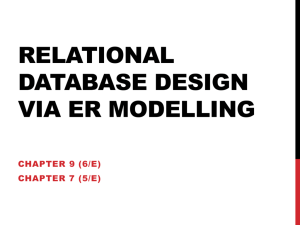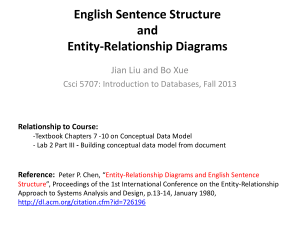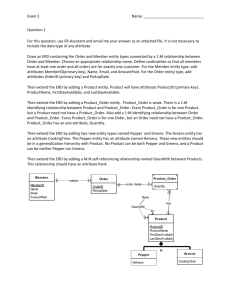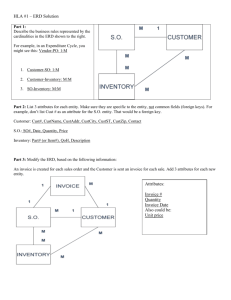Chapter5-ERD-to-Relational
advertisement
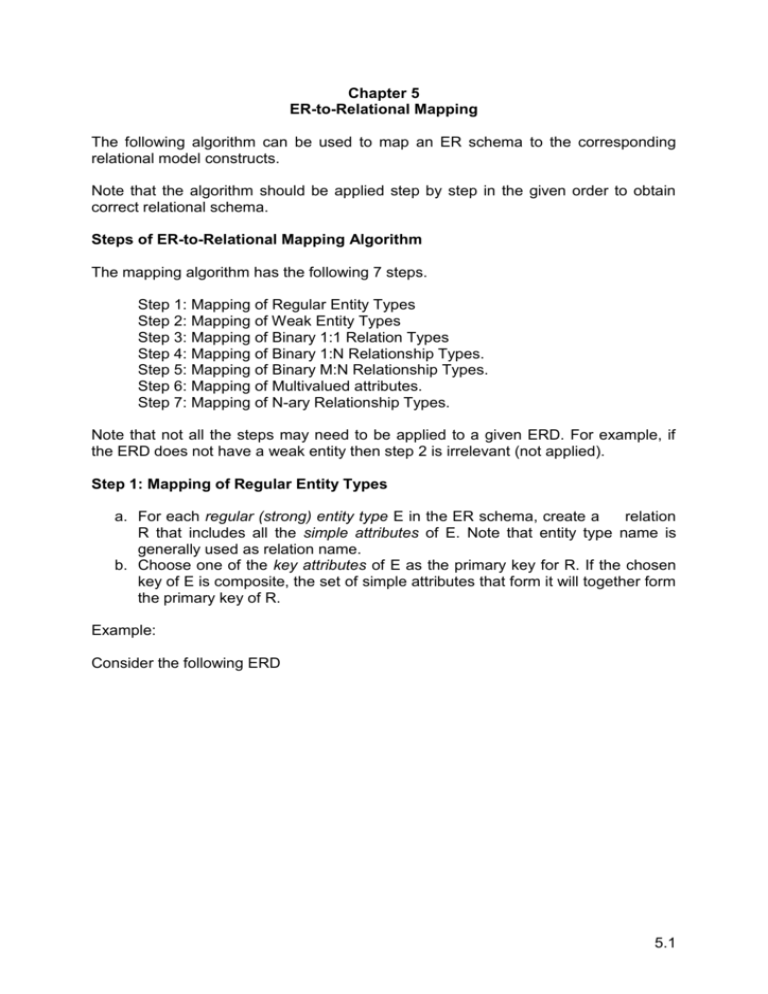
Chapter 5
ER-to-Relational Mapping
The following algorithm can be used to map an ER schema to the corresponding
relational model constructs.
Note that the algorithm should be applied step by step in the given order to obtain
correct relational schema.
Steps of ER-to-Relational Mapping Algorithm
The mapping algorithm has the following 7 steps.
Step 1: Mapping of Regular Entity Types
Step 2: Mapping of Weak Entity Types
Step 3: Mapping of Binary 1:1 Relation Types
Step 4: Mapping of Binary 1:N Relationship Types.
Step 5: Mapping of Binary M:N Relationship Types.
Step 6: Mapping of Multivalued attributes.
Step 7: Mapping of N-ary Relationship Types.
Note that not all the steps may need to be applied to a given ERD. For example, if
the ERD does not have a weak entity then step 2 is irrelevant (not applied).
Step 1: Mapping of Regular Entity Types
a. For each regular (strong) entity type E in the ER schema, create a
relation
R that includes all the simple attributes of E. Note that entity type name is
generally used as relation name.
b. Choose one of the key attributes of E as the primary key for R. If the chosen
key of E is composite, the set of simple attributes that form it will together form
the primary key of R.
Example:
Consider the following ERD
5.1
We create the relations EMPLOYEE, DEPARTMENT, and PROJECT in the
relational schema corresponding to the regular entities in the ER diagram.
SSN, DNUMBER, and PNUMBER are the primary keys for the relations
EMPLOYEE, DEPARTMENT, and PROJECT as shown.
EMPLOYEE
FNAME MINT
LNAME
SSN
BDATE
ADDRESS SEX
SALARY
DEPARTMENT
DNAME
DNUMBER
PROJECT
PNAME
PNUMBER
PLOCATION
Step 2: Mapping of Weak Entity Types
a. For each weak entity type W in the ER schema with owner entity type E,
create a relation R and include all simple attributes (or simple components of
composite attributes) of W as attributes of R.
b. In addition, include as foreign key attributes of R the primary key attribute(s)
of the relation(s) that correspond to the owner entity type(s).
c. The primary key of R is the combination of the primary key(s) of the owner(s)
and the partial key of the weak entity type W, if any.
5.2
Example: The application of step 2 to our ERD is as follows: We create
relation DEPENDENT in this step to correspond to the weak entity type
DEPENDENT and include the primary key SSN of the EMPLOYEE relation as
a foreign key attribute of DEPENDENT (renamed to ESSN).
The primary key of the DEPENDENT relation is the combination {ESSN,
DEPENDENT_NAME} because DEPENDENT_NAME is the partial key of
DEPENDENT.
DEPENDENT
ESSN DEPENDENT_NAME
SEX
BDATE
RELATIONSHIP
Note that after step 2, our relational schema will have the following four
relations.
EMPLOYEE
FNAME MINT
DEPARTMENT
DNAME
LNAME
SSN
BDATE
ADDRESS SEX
SALARY
DNUMBER
PROJECT
PNAME
PNUMBER
PLOCATION
DEPENDENT
ESSN DEPENDENT_NAME
SEX
BDATE
RELATIONSHIP
5.3
Step 3: Mapping of Binary 1:1 Relation Types
a. For each binary 1:1 relationship type R in the ER schema, identify the
relations S and T that correspond to the entity types participating in R.
There are three possible approaches:
(1)
Foreign Key approach: Choose one of the relations-S, say-and
include a foreign key in S the primary key of T. It is better to
choose an entity type with total participation in R in the role of S.
Example: In our example, 1:1 relation MANAGES is mapped by
choosing the participating entity type DEPARTMENT to serve in
the role of S, because its participation in the MANAGES
relationship type is total.
DEPARTMENT
DNAME
DNUMBER
MGRSSN
MGRSTARTDATE
(2)
Merged relation option: An alternate mapping of a 1:1 relationship
type is possible by merging the two entity types and the
relationship into a single relation. This may be appropriate when
both participations are total.
(3)
Cross-reference or relationship relation option: The third
alternative is to set up a third relation R for the purpose of crossreferencing the primary keys of the two relations S and T
representing the entity types.
Step 4: Mapping of Binary 1:N Relationship Types
a. For each regular binary 1:N relationship type R, identify the relation S that
represent the participating entity type at the N-side of the relationship type.
b. Include as foreign key in S the primary key of the relation T that represents the
other entity type participating in R.
c. Include any simple attributes of the 1:N relation type as attributes of S.
Example: 1:N relationship types WORKS_FOR, CONTROLS, and
SUPERVISION (recursive relationship) in the figure. For WORKS_FOR we
include the primary key DNUMBER of the DEPARTMENT relation as foreign
key in the EMPLOYEE relation and call it DNO.
EMPLOYEE
FNAME MINT LNAME SSN BDATE ADDRESS SEX SALARY SUPERSSN DNO
PROJECT
PNAME
PNUMBER
PLOCATION
DNUM
5.4
Step 5: Mapping of Binary M:N Relationship Types
a. For each regular binary M:N relationship type R, create a new relation S to
represent R.
b. Include as foreign key attributes in S the primary keys of the relations that
represent the participating entity types; their combination will form the primary
key of S.
c. Also include any simple attributes of the M:N relationship type (or simple
components of composite attributes) as attributes of S.
Example: The M:N relationship type WORKS_ON from the ER diagram is
mapped by creating a relation WORKS_ON in the relational database
schema. The primary keys of the PROJECT and EMPLOYEE relations are
included as foreign keys in WORKS_ON and renamed PNO and ESSN,
respectively.
Attribute HOURS in WORKS_ON represents the HOURS attribute of the
relation type. The primary key of the WORKS_ON relation is the combination
of the foreign key attributes {ESSN, PNO}.
WORKS_ON
ESSN
PNO
HOURS
Step 6: Mapping of Multivalued Attributes
a. For each multivalued attribute A, create a new relation R. This relation R will
include an attribute corresponding to A, plus the primary key attribute K-as a
foreign key in R-of the relation that represents the entity type of relationship
type that has A as an attribute.
b. The primary key of R is the combination of A and K. If the multivalued
attribute is composite, we include its simple components.
Example: The relation DEPT_LOCATIONS is created. The attribute
DLOCATION represents the multivalued attribute LOCATIONS of
DEPARTMENT, while DNUMBER-as foreign key-represents the primary key
of the DEPARTMENT relation. The primary key of R is the combination of
{DNUMBER, DLOCATION}.
DEPT_LOCATION
DNUMBER
DLOCATION
Now the complete mapping is given on the next page:
5.5
5.6
Step 7: Mapping of N-ary Relationship Types
a. For each n-ary relationship type R, where n>2, create a new relationship S to
represent R.
b. Include as foreign key attributes in S the primary keys of the relations that
represent the participating entity types.
c. Also include any simple attributes of the n-ary relationship type (or simple
components of composite attributes) as attributes of S.
Example: The relationship type SUPPY in the ERD below can be mapped to
the relation SUPPLY shown in the relational schema, whose primary key is the
combination of the three foreign keys {SNAME, PARTNO, PROJNAME}
5.7
Summary of Mapping Constructs and Constraints
Correspondence between ER and Relational Models
ER Model
Entity type
1:1 or 1:N relationship type
M:N relationship type
n-ary relationship type
Simple attribute
Composite attribute
Multivalued attribute
Value set
Key attribute
Relational Model
“Entity” relation
Foreign key (or “relationship” relation)
“Relationship” relation and two foreign keys
“Relationship” relation and n foreign keys
Attribute
Set of simple component attributes
Relation and foreign key
Domain
Primary (or secondary) key
Last point
One ERD has been mapped to relational conceptual schema, you need to normalize
the relation using a technique called NORMALIZATION. Normalization is the topic of
our next chapter.
Exercise
Map the following ERD to relational conceptual schema.
5.8

